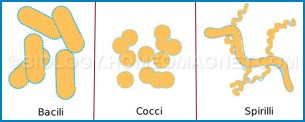In the year 1872 scientist Cohn classified bacteria to 4 major types depending on their shapes are as follow: –
1) Cocci: These types of bacteria are unicellular, spherical or elliptical shape. Either they may remain as a single cell or may aggregate together for various configurations. They are as follow:
i) Monococcus: – they are also called micrococcus and represented by single, discrete round cell. Example: Micrococcus flavus.
ii) Diplococcus: – the cell of the Diplococcus divides ones in a particular plane and after division, the cells remain attached to each other. Example: – Diplococcus pneumonia.

iii) Streptococcus: – here the cells divide repeatedly in one plane to form chain of cells. Example: – Streptococcus pyogenes.
iv) Tetracoccus: – this consists of four round cells, which defied in two planes at a right angles to one another. Example: – Gaffkya tetragena.
v) Staphylococcus: – here the cells divided into three planes forming a structured like bunches of grapes giving and irregular configuration. Example: – Staphylococcus aureus.
vi) Sarcina: -in this case this cells divide in three planes but they form a cube like configuration consisting of eight or sixteen cells but they have a regular shape. Example: –Sarcina lutea.
2) Bacilli: – this are rod shaped or cylindrical bacteria which either remain singly or in pairs. Example: –Bacillus cereus.
3) Vibro: -the vibro are the curved, comma shaped bacteria and represented by a single genus. Example: – Vibro cholerae.
4) Spirilla: – this type of bacteria are spiral or spring like with multiple curvature and terminal flagella. Example: –Spirillum volutans.
Classification of bacteria on the basis of nutrition: –
On the basis of nutrition bacteria are classified as following:
1) Autotropic bacteria: – these bacteria are nonpathogenic, free living, self sustaining in nature, which prepare their own food by utilisation of solar energy and inorganic components like carbon dioxide, nitrogen etc. They are of two types:
i) Photoautotrophs: – these bacteria contain bacterio-chlorophyll and bacterioviridin and can prepare their own food by fixing carbon dioxide the nature by the utilisation of solar energy.
ii) Chemoautotrophs: -these are the bacteria which prepare they are food by deriving the energy from oxidation of inorganic substances like nitrogen dioxide, carbon dioxide etc. and they can also fix carbon dioxide and water for their nutrition.
2) Heterotrophic bacteria: – this type of bacteria cannot fix inorganic Carbone but rather depend on external organic Carbone for their nourishment. They also can be classified on the basis of presence and absence of flight and on the basis of the media on which the bacteria are growing.
Classification of bacteria on the basis of cell wall: –

Depending upon the staining reactions by Gram stain bacteria can be classified into two types, those are: –
i) Gram positive: -this type of bacteria retains the crystal fire lit or gram stain which appear violate. Example: – Streptococcus.
ii) Gram negative: – they do not retain the gram stain, but they take up the red colour of the counter stain. Example: – Saffranin (Escherichia coli).
Classification on the basis of temperature response: –
Bacteria can be classified into four major types on the basis of their temperatures response as indicated below: –
i) Psychrophilic bacteria: -These type of bacteria grows just above the freezing temperature, they can cause contamination of food stored in the refrigerator. Example: -Pseudomonas.
ii) Mesophilic bacteria: -These bacteria grow at normal temperature in the water bodies, food products, liberate gas and cause change in texture. Example: -Lactobacillus.
iii) Thermophilic bacteria: – These types of bacteria can survive at higher temperature and can withstand the pasteurization temperature. Example: – Clostridium, Bacillus.
iv) Thermophilic bacteria: – These types of bacteria can survive pasteurization but cannot grow at the pasteurization temperature. Example: – Micrococcus, Streptococcus.
Classification of bacteria on the basis of number of flagella: –
On the basis of flagella the bacteria can be classified: –
i) Atrichos: – These bacteria has no flagella. Example: -Corynebacterium diptherae.
ii) Monotrichous: – One flagellum is attached to one end of the bacteria cell. Example: – Vibro cholera.
iii) Lophotrichous: – Bunch of flagella is attached to one end of the bacteria cell. Example: – Pseudomonas.
iv) Amphitrichous: – Bunch of flagella arising from both end of the bacteria cell. Example: – Rhodospirillum rubrum.
v) Peritrichous : – The flagella are evenly distributed surrounding the entire bacterial cell. Example: -Bacillus.
Source: Biology.com
